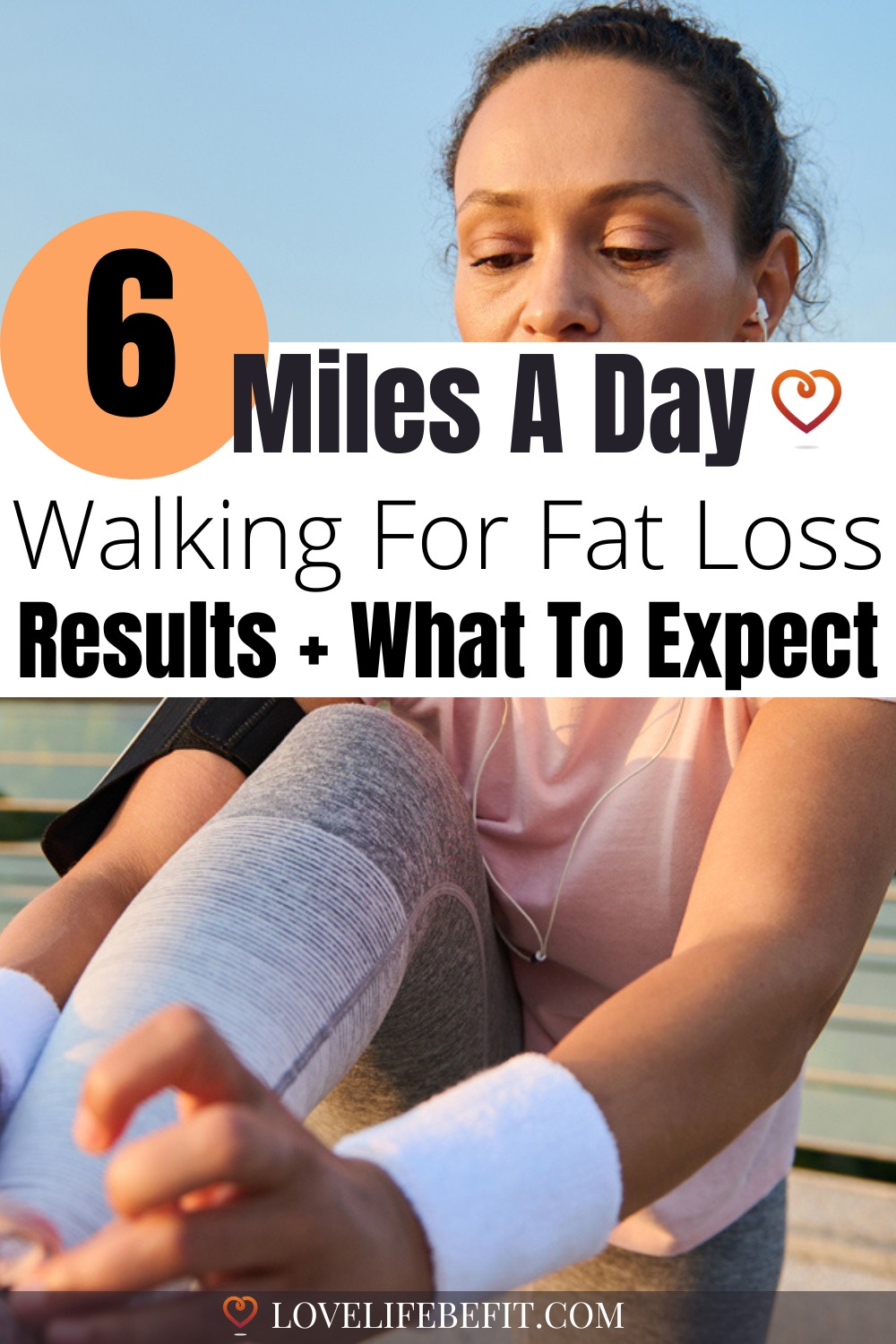Walking 6 Miles A Day: Getting Started + Weight Loss Results
Tell your friends you’re planning on walking 6 miles a day and they’ll probably think you’re getting carried away. It’s an ambitious target but you don’t have to walk your 6 miles all in one go.
Think of it as three short 2 mile walks a day. Walk to work, walk to meet your friends, walk to do your errands – whenever there’s a chance to walk somewhere, take it!
Walking has always been my go-to form of exercise if I’m injured or too tired to run. I find it’s easier to lose weight when I walk. Compared with running, it doesn’t make me so hungry and I’m less tempted by treats.
So if you’ve ruled out running and still want all the health benefits of being fit, walking 6 miles a day could be the answer.

How Far Is 6 Miles?
6 miles is 10,560 yards or 9,654 meters – a little under 10K (6.21 miles).
If you prefer to count distance in steps using a fitness tracker, the number of steps it takes to walk 6 miles will depend on fitness levels, average step length (stride length), and walking pace.
As a rough guide, walking 6 miles is equivalent to 12,000 to 14,400 steps.
Walking 6 miles a day will easily exceed the popular target of walking 10,000 steps a day.

How Long Does It Take to Walk 6 Miles?
Walking 6 miles in one go is a big time commitment. Provided you’re not hiking in the hills or on rugged paths, most people can walk 6 miles in 90 to 108 minutes on flat terrain. That’s just under two hours.
This is walking briskly, at a pace of 15 to 18 minutes per mile or an average walking speed of just over 3 to 4 miles per hour (mph).
How fit you are will have the biggest impact on how fast you can walk but everything from age and gender to effort level, terrain, and walking uphills makes a difference. Even the weather can affect your walking speed.
Some people can power walk 6 miles in less than 72 minutes at speeds of 5 mph (12 minutes per mile).
For others, it can take considerably longer. At a leisurely walking speed of 2.5 miles per hour, walking 6 miles takes 2 hours 24 minutes.
When you’re walking for fitness and weight loss, the aim is to walk at a brisk pace. Your heart rate will be elevated but you can still walk and talk. You’ll be making an effort to maintain your pace.
The chart below shows how long it takes to walk 6 miles at different paces:
| Walking Speed (mph) | Walking Pace (min/mile) | Time Taken To Walk 6 Miles (hour: min) |
| 2.5 | 24.0 | 2:24 |
| 2.75 | 21.8 | 2:11 |
| 3.0 | 20.0 | 2:00 |
| 3.25 | 18.5 | 1:52 |
| 3.5 | 17.1 | 1:43 |
| 3.75 | 16.0 | 1:36 |
| 4.0 | 15.0 | 1:30 |
| 4.25 | 14.1 | 1:25 |
| 4.5 | 13.3 | 1:20 |
| 4.75 | 12.6 | 1:16 |
| 5.0 | 12.0 | 1:12 |

How Many Calories Burned Walking 6 Miles A Day?
Walking is one of the best ways to burn calories, You can burn almost as many calories walking a mile as you can running.
Expect to burn 80-100 calories a mile depending on your body weight and walking speed.
Calories burned walking 6 miles will depend on your fitness level, current body weight, and time spent walking. Use our calories burned walking 6 miles chart or our Calories Burned Walking Calculator to find out how many more calories you can burn from walking.
The number of calories burned walking 6 miles varies from 336 to 1422! But typically you can expect to burn approximately 500 to 700 calories walking 6 miles at a brisk pace.
Try walking uphill and your calorie expenditure will skyrocket! One of the big pluses of walking for weight loss is that the heavier you are, the more calories you burn. That’s a great incentive when you first start walking!
Calculating calories burned walking is based on metabolic equivalents METs. This guide will tell you all about calculating calories burned and how many calories you burn a day.
Can Walking 6 Miles A Day Help You Lose Weight?
Walking 6 miles a day is an excellent way to lose weight. Calories burned are high and it has less impact on your body than running for weight loss.
This means most people can walk every day without getting too sore.
But there are two factors behind hitting your weight loss goals: exercise and diet. Both are important.
To lose weight you need a calorie deficit where the calories burned from exercise and daily activities are more than the calories you eat.
You can create a calorie deficit by:
- Exercising more.
- Eating less.
- Or a combination of exercising more and eating less.
Diets without exercise tend to fail because you end up burning muscle as well as body fat.
Equally, if you’re exercising more to lose weight, it’s still best to watch what you eat. Otherwise, there’s a risk of blowing your calorie deficit on sticky high-fat treats. A large slice of cake will quickly reduce your calorie deficit from walking.
To get the best results when you’re losing weight try and make small improvements to your eating habits. Aim to eat healthy food with these tips for what to eat after walking for weight loss.
Walking 5 to 6 miles a day is a sweet spot for walking for weight loss. It takes a deficit of 3500 calories to burn a pound of body fat, so you can expect to lose a few pounds a week.

Walking 6 Miles A Day Weight Loss Results
Weight loss results will depend as much on what you eat as much as your walking routine but 6 miles a day is a significant amount of exercise. You can expect to lose weight.
How much weight you lose will depend on your starting weight and eating habits. This guide: How Much Should I Walk According To My BMI will help you find your weight loss target.
Most people will lose 1 – 2 pounds per week but it could be substantially more, especially when you first start exercising. It may not sound very much but these pounds add up. Expect to lose 5 to 8 pounds a month and 60 to 100 pounds a year depending on your starting weight.
For best results keep challenging yourself. To begin with, you may walk slowly if you haven’t exercised for a long time. As you get fitter walk at a moderate pace, fitter still, aim for a brisk walk.
Gaining Weight
Some people start gaining weight when they first start exercising. If you suddenly jump into walking 6 miles a day it’s going to be a bit of a shock for your body.
Exercise stresses your muscles causing micro-tears. The result is muscle soreness and inflammation. Your body retains water to help the repair process. It’s temporary. As your body adjusts to walking you’ll lose the water weight.
What Happens To Your Body
Walking six miles every day will make a big change to your physique. You’re going to get stronger! Expect strong leg muscles and core strength. Muscles weigh more than body fat so it’s possible your body fat percentage will decrease but not your weight.
Get the tape measure out and check what’s happening. If you’re getting leaner, you’re on the right track. Otherwise, you need to watch what you eat. Find out more about gaining weight.

Health Benefits Of Walking 6 Miles A Day
It’s not just weight loss that’s helped by walking. Expect benefits from improved mental health to better cardiovascular fitness.
#1 Mental Health
Walking outdoors gives you a break from daily life and can help you de-stress and clear your head. Exercise can help reduce anxiety and may help with depression.
#2 Cardiovascular Health
Walking 6 miles a day will get your heart pumping leading to improved cardiovascular health. Regular exercise can help protect against heart disease with reduced cholesterol levels, lower blood pressure, and improved circulation.
#3 Bone Health
Regular walks improve your balance and coordination and the impact of walking leads to stronger bones. There’s a reduced risk of osteoporosis risk and joint pain as you age. Just don’t overdo it.
Find out more about the benefits of walking.

Tips And How To Get Started
These tips will help you start walking and build a weekly routine.
#1 Check In With Your Doctor
If you haven’t exercised for a while, you’re carrying a lot of excess weight or you have an existing medical condition, get checked out by your doctor before starting your walking program.
#2 Walk Properly
Walking may be natural but so many people shuffle along without good walking posture. Learn how to walk properly before you start.
#3 Ease Into The Distance
If you’re new to walking, don’t start walking 6 miles on day 1. Gradually increase the distance walked. Walking 2 miles a day is a good place to start. When you can walk 2 miles comfortably, try walking 3 miles a day for a week, then 4 miles, 5 miles, and finally six miles a day.
Alternatively, try our Fat Buster Walking Plan. You’ll build up to walking 5 miles a day over 9 weeks. In week 10, just add an extra mile to your daily walking workouts.
#4 Mix Things Up
As you get fitter, make your walks more challenging. Instead of always walking at the same pace, add walking intervals and incline walking for greater intensity.
#5 Take Rest Days
Some people can walk every day but 6 miles is a significant distance. You may benefit from taking one or two rest days a week.
#6 Add Strength Training
Walking 6 miles a day hits the recommended minimum targets from the Centers for Disease Control and Prevention (CDC) for moderate-intensity aerobic activity of 150 minutes a week. You’re going to smash it!
But CDC also recommends muscle-strengthening activities. Hit the minimum target of 2 strength training sessions a week with these bodyweight exercises or a regular yoga class. The strength exercises will aid your walking and help prevent injuries.
#7 Add Steps
Look for opportunities to walk more during the day. Here are some suggestions to improve your daily step count.

Thoughts From Love Life Be Fit
Walking 6 miles a day is a great way to exercise more. You can expect to lose weight, get stronger, and improve your health.
Make sure you watch what you eat and add strength exercises for best results. Start slowly and gradually increase the daily distance from 2 miles to walking 4 miles a day until you can make 6 miles a day a regular habit.







